Reducing Staff Turnover: Motivation, Job Satisfaction, Leadership
VerifiedAdded on 2023/04/21
|79
|17379
|283
Thesis and Dissertation
AI Summary
This dissertation investigates the role of motivation, job satisfaction, and leadership in reducing staff turnover at Hong Kong Airlines. It begins with an introduction and literature review covering theories of motivation, job satisfaction, leadership styles, and factors influencing employee turnover. The research employs a primary research approach, using a survey of 100 Hong Kong Airlines employees. Quantitative analysis, including regression analysis, reveals a strong relationship between leadership, motivation, job satisfaction, and employee turnover. The study concludes with recommendations for Hong Kong Airlines to improve employee retention by focusing on these key factors.
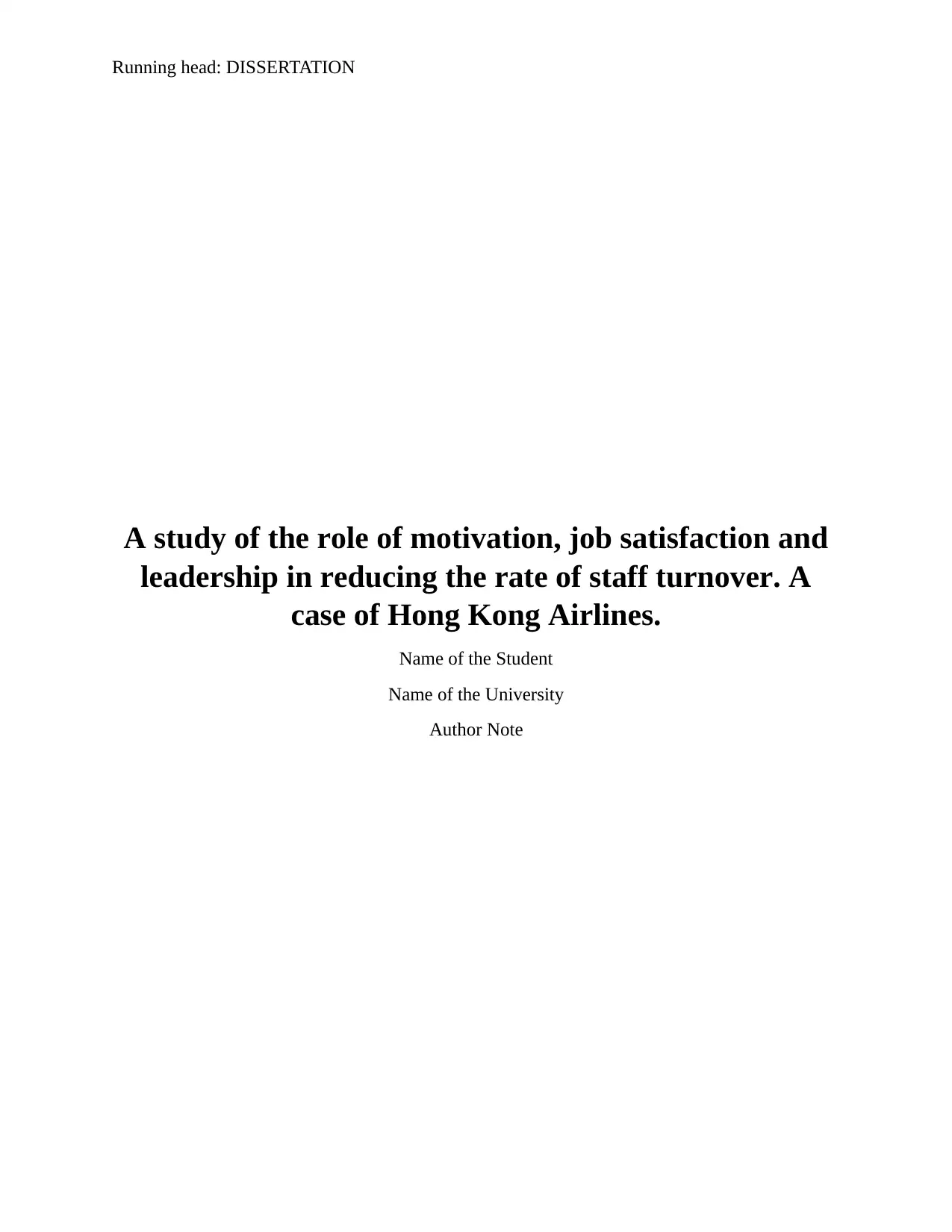
Running head: DISSERTATION
A study of the role of motivation, job satisfaction and
leadership in reducing the rate of staff turnover. A
case of Hong Kong Airlines.
Name of the Student
Name of the University
Author Note
A study of the role of motivation, job satisfaction and
leadership in reducing the rate of staff turnover. A
case of Hong Kong Airlines.
Name of the Student
Name of the University
Author Note
Paraphrase This Document
Need a fresh take? Get an instant paraphrase of this document with our AI Paraphraser
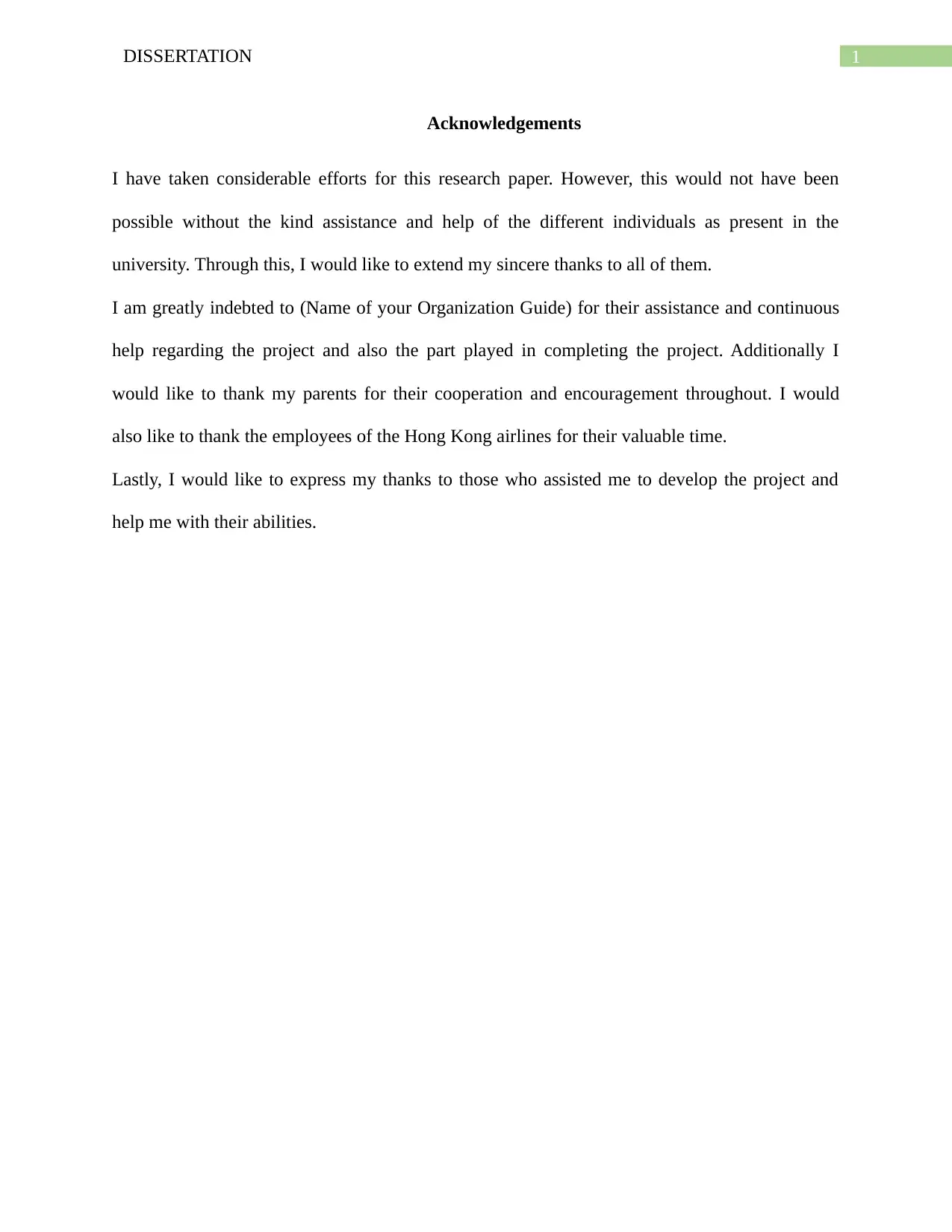
1DISSERTATION
Acknowledgements
I have taken considerable efforts for this research paper. However, this would not have been
possible without the kind assistance and help of the different individuals as present in the
university. Through this, I would like to extend my sincere thanks to all of them.
I am greatly indebted to (Name of your Organization Guide) for their assistance and continuous
help regarding the project and also the part played in completing the project. Additionally I
would like to thank my parents for their cooperation and encouragement throughout. I would
also like to thank the employees of the Hong Kong airlines for their valuable time.
Lastly, I would like to express my thanks to those who assisted me to develop the project and
help me with their abilities.
Acknowledgements
I have taken considerable efforts for this research paper. However, this would not have been
possible without the kind assistance and help of the different individuals as present in the
university. Through this, I would like to extend my sincere thanks to all of them.
I am greatly indebted to (Name of your Organization Guide) for their assistance and continuous
help regarding the project and also the part played in completing the project. Additionally I
would like to thank my parents for their cooperation and encouragement throughout. I would
also like to thank the employees of the Hong Kong airlines for their valuable time.
Lastly, I would like to express my thanks to those who assisted me to develop the project and
help me with their abilities.
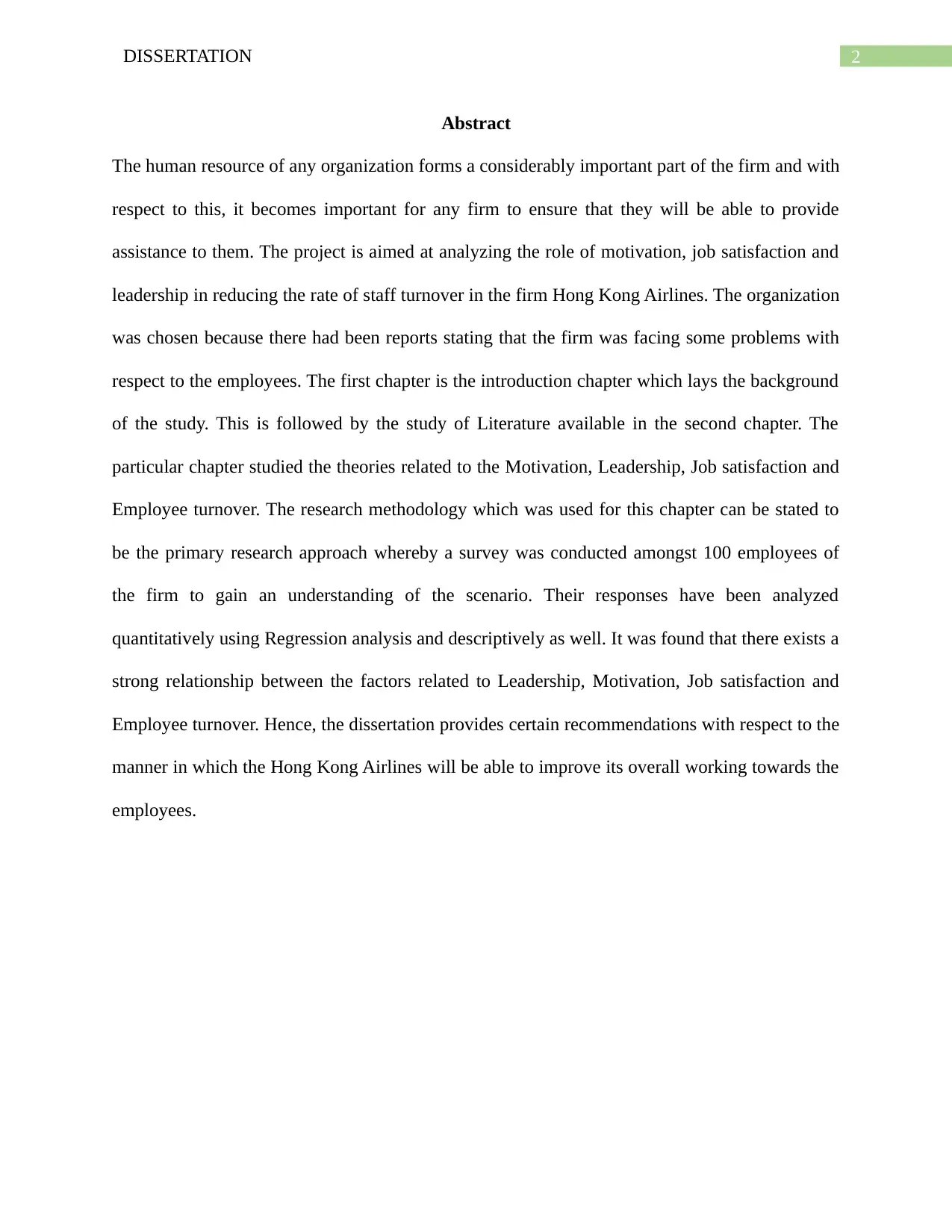
2DISSERTATION
Abstract
The human resource of any organization forms a considerably important part of the firm and with
respect to this, it becomes important for any firm to ensure that they will be able to provide
assistance to them. The project is aimed at analyzing the role of motivation, job satisfaction and
leadership in reducing the rate of staff turnover in the firm Hong Kong Airlines. The organization
was chosen because there had been reports stating that the firm was facing some problems with
respect to the employees. The first chapter is the introduction chapter which lays the background
of the study. This is followed by the study of Literature available in the second chapter. The
particular chapter studied the theories related to the Motivation, Leadership, Job satisfaction and
Employee turnover. The research methodology which was used for this chapter can be stated to
be the primary research approach whereby a survey was conducted amongst 100 employees of
the firm to gain an understanding of the scenario. Their responses have been analyzed
quantitatively using Regression analysis and descriptively as well. It was found that there exists a
strong relationship between the factors related to Leadership, Motivation, Job satisfaction and
Employee turnover. Hence, the dissertation provides certain recommendations with respect to the
manner in which the Hong Kong Airlines will be able to improve its overall working towards the
employees.
Abstract
The human resource of any organization forms a considerably important part of the firm and with
respect to this, it becomes important for any firm to ensure that they will be able to provide
assistance to them. The project is aimed at analyzing the role of motivation, job satisfaction and
leadership in reducing the rate of staff turnover in the firm Hong Kong Airlines. The organization
was chosen because there had been reports stating that the firm was facing some problems with
respect to the employees. The first chapter is the introduction chapter which lays the background
of the study. This is followed by the study of Literature available in the second chapter. The
particular chapter studied the theories related to the Motivation, Leadership, Job satisfaction and
Employee turnover. The research methodology which was used for this chapter can be stated to
be the primary research approach whereby a survey was conducted amongst 100 employees of
the firm to gain an understanding of the scenario. Their responses have been analyzed
quantitatively using Regression analysis and descriptively as well. It was found that there exists a
strong relationship between the factors related to Leadership, Motivation, Job satisfaction and
Employee turnover. Hence, the dissertation provides certain recommendations with respect to the
manner in which the Hong Kong Airlines will be able to improve its overall working towards the
employees.
⊘ This is a preview!⊘
Do you want full access?
Subscribe today to unlock all pages.

Trusted by 1+ million students worldwide
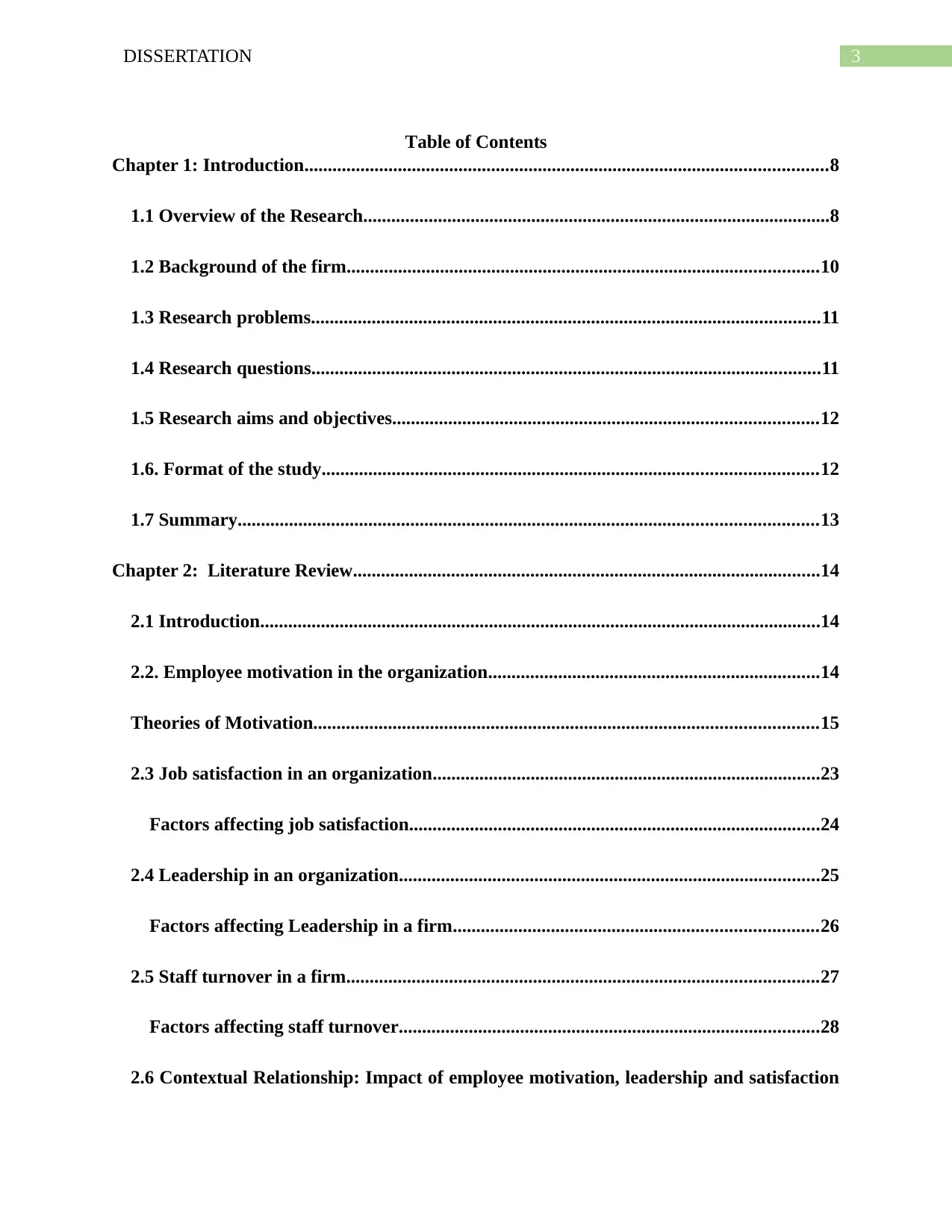
3DISSERTATION
Table of Contents
Chapter 1: Introduction................................................................................................................8
1.1 Overview of the Research....................................................................................................8
1.2 Background of the firm.....................................................................................................10
1.3 Research problems.............................................................................................................11
1.4 Research questions.............................................................................................................11
1.5 Research aims and objectives...........................................................................................12
1.6. Format of the study..........................................................................................................12
1.7 Summary............................................................................................................................13
Chapter 2: Literature Review....................................................................................................14
2.1 Introduction........................................................................................................................14
2.2. Employee motivation in the organization.......................................................................14
Theories of Motivation............................................................................................................15
2.3 Job satisfaction in an organization...................................................................................23
Factors affecting job satisfaction........................................................................................24
2.4 Leadership in an organization..........................................................................................25
Factors affecting Leadership in a firm..............................................................................26
2.5 Staff turnover in a firm.....................................................................................................27
Factors affecting staff turnover..........................................................................................28
2.6 Contextual Relationship: Impact of employee motivation, leadership and satisfaction
Table of Contents
Chapter 1: Introduction................................................................................................................8
1.1 Overview of the Research....................................................................................................8
1.2 Background of the firm.....................................................................................................10
1.3 Research problems.............................................................................................................11
1.4 Research questions.............................................................................................................11
1.5 Research aims and objectives...........................................................................................12
1.6. Format of the study..........................................................................................................12
1.7 Summary............................................................................................................................13
Chapter 2: Literature Review....................................................................................................14
2.1 Introduction........................................................................................................................14
2.2. Employee motivation in the organization.......................................................................14
Theories of Motivation............................................................................................................15
2.3 Job satisfaction in an organization...................................................................................23
Factors affecting job satisfaction........................................................................................24
2.4 Leadership in an organization..........................................................................................25
Factors affecting Leadership in a firm..............................................................................26
2.5 Staff turnover in a firm.....................................................................................................27
Factors affecting staff turnover..........................................................................................28
2.6 Contextual Relationship: Impact of employee motivation, leadership and satisfaction
Paraphrase This Document
Need a fresh take? Get an instant paraphrase of this document with our AI Paraphraser
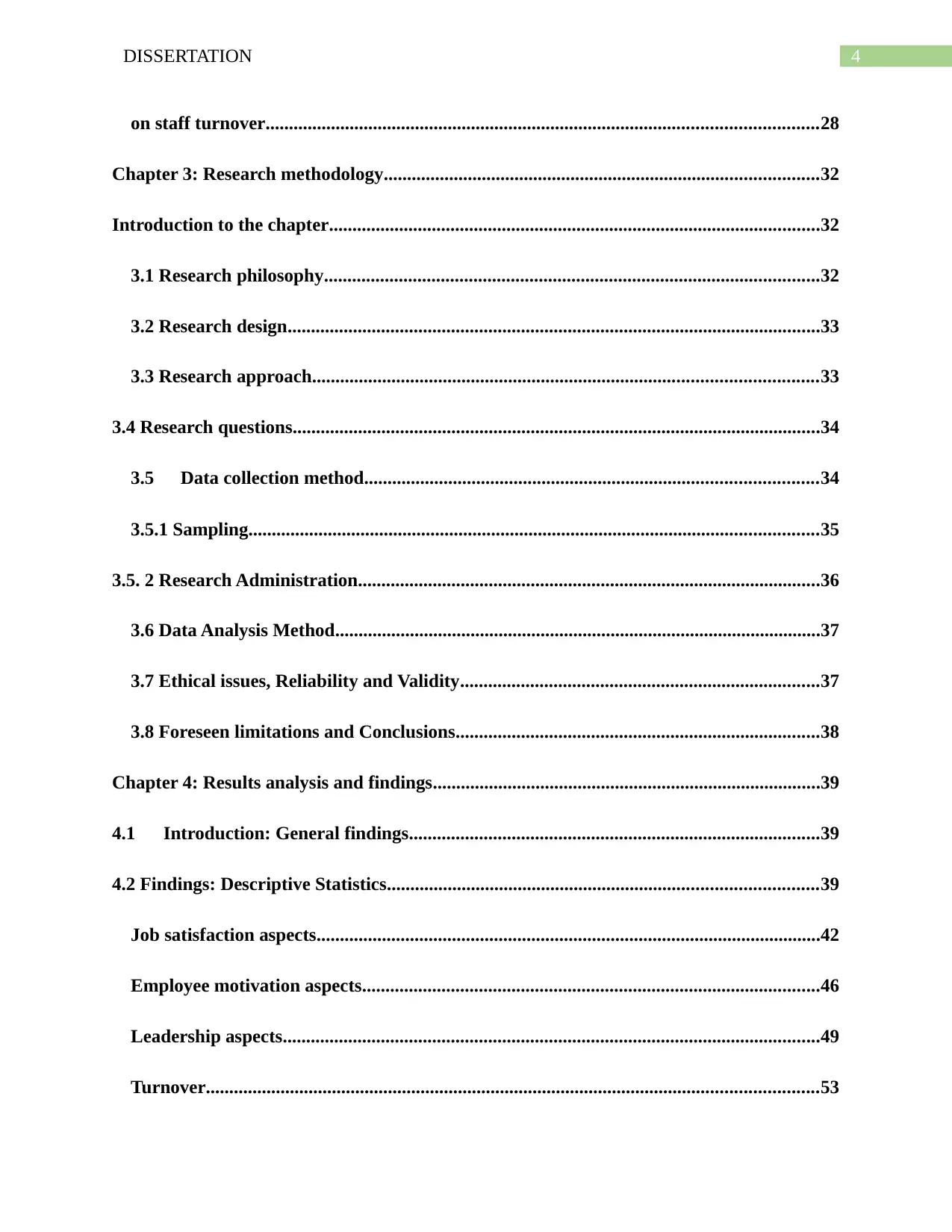
4DISSERTATION
on staff turnover......................................................................................................................28
Chapter 3: Research methodology.............................................................................................32
Introduction to the chapter.........................................................................................................32
3.1 Research philosophy..........................................................................................................32
3.2 Research design..................................................................................................................33
3.3 Research approach............................................................................................................33
3.4 Research questions.................................................................................................................34
3.5 Data collection method.................................................................................................34
3.5.1 Sampling..........................................................................................................................35
3.5. 2 Research Administration...................................................................................................36
3.6 Data Analysis Method........................................................................................................37
3.7 Ethical issues, Reliability and Validity.............................................................................37
3.8 Foreseen limitations and Conclusions..............................................................................38
Chapter 4: Results analysis and findings...................................................................................39
4.1 Introduction: General findings........................................................................................39
4.2 Findings: Descriptive Statistics............................................................................................39
Job satisfaction aspects............................................................................................................42
Employee motivation aspects..................................................................................................46
Leadership aspects...................................................................................................................49
Turnover...................................................................................................................................53
on staff turnover......................................................................................................................28
Chapter 3: Research methodology.............................................................................................32
Introduction to the chapter.........................................................................................................32
3.1 Research philosophy..........................................................................................................32
3.2 Research design..................................................................................................................33
3.3 Research approach............................................................................................................33
3.4 Research questions.................................................................................................................34
3.5 Data collection method.................................................................................................34
3.5.1 Sampling..........................................................................................................................35
3.5. 2 Research Administration...................................................................................................36
3.6 Data Analysis Method........................................................................................................37
3.7 Ethical issues, Reliability and Validity.............................................................................37
3.8 Foreseen limitations and Conclusions..............................................................................38
Chapter 4: Results analysis and findings...................................................................................39
4.1 Introduction: General findings........................................................................................39
4.2 Findings: Descriptive Statistics............................................................................................39
Job satisfaction aspects............................................................................................................42
Employee motivation aspects..................................................................................................46
Leadership aspects...................................................................................................................49
Turnover...................................................................................................................................53
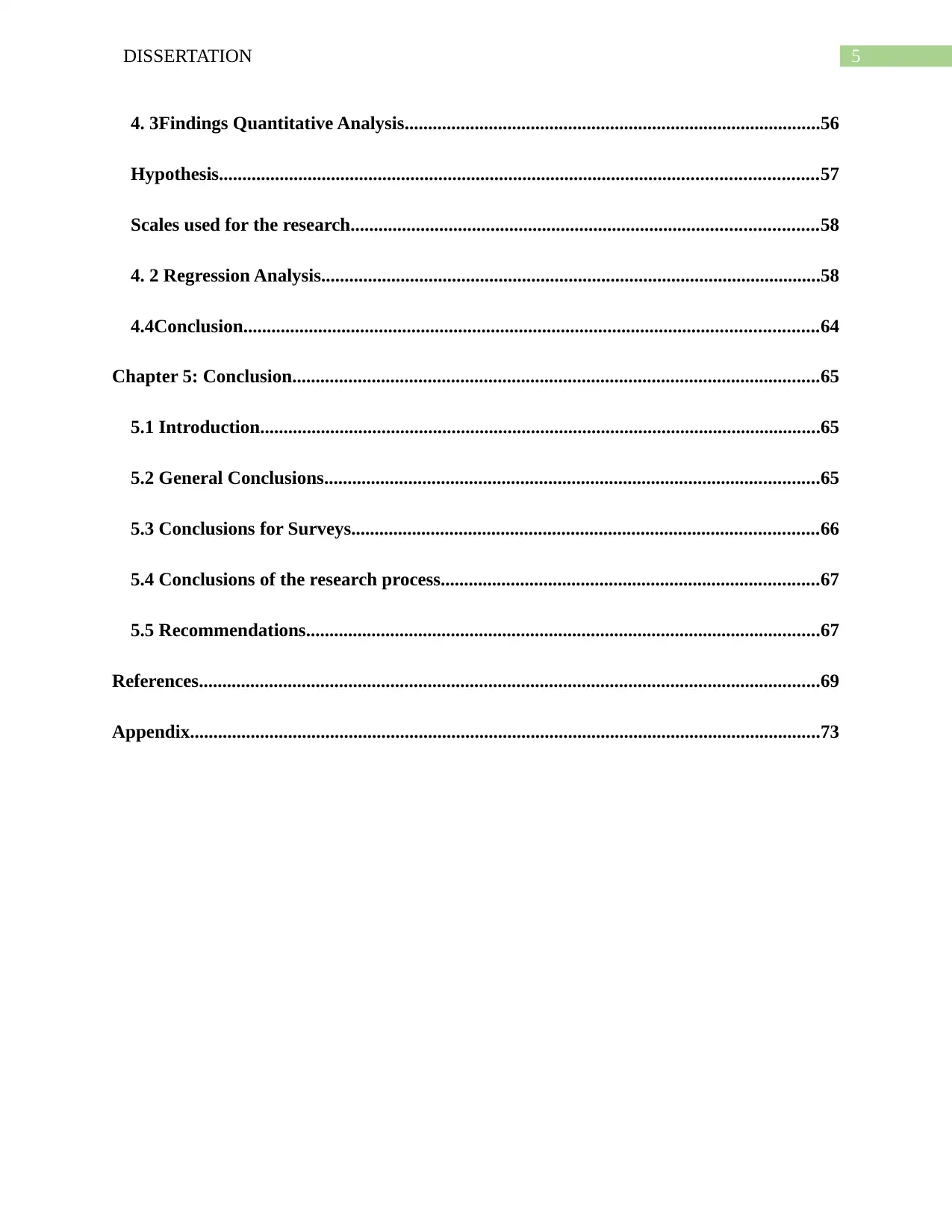
5DISSERTATION
4. 3Findings Quantitative Analysis.........................................................................................56
Hypothesis................................................................................................................................57
Scales used for the research....................................................................................................58
4. 2 Regression Analysis...........................................................................................................58
4.4Conclusion...........................................................................................................................64
Chapter 5: Conclusion.................................................................................................................65
5.1 Introduction........................................................................................................................65
5.2 General Conclusions..........................................................................................................65
5.3 Conclusions for Surveys....................................................................................................66
5.4 Conclusions of the research process.................................................................................67
5.5 Recommendations..............................................................................................................67
References.....................................................................................................................................69
Appendix.......................................................................................................................................73
4. 3Findings Quantitative Analysis.........................................................................................56
Hypothesis................................................................................................................................57
Scales used for the research....................................................................................................58
4. 2 Regression Analysis...........................................................................................................58
4.4Conclusion...........................................................................................................................64
Chapter 5: Conclusion.................................................................................................................65
5.1 Introduction........................................................................................................................65
5.2 General Conclusions..........................................................................................................65
5.3 Conclusions for Surveys....................................................................................................66
5.4 Conclusions of the research process.................................................................................67
5.5 Recommendations..............................................................................................................67
References.....................................................................................................................................69
Appendix.......................................................................................................................................73
⊘ This is a preview!⊘
Do you want full access?
Subscribe today to unlock all pages.

Trusted by 1+ million students worldwide
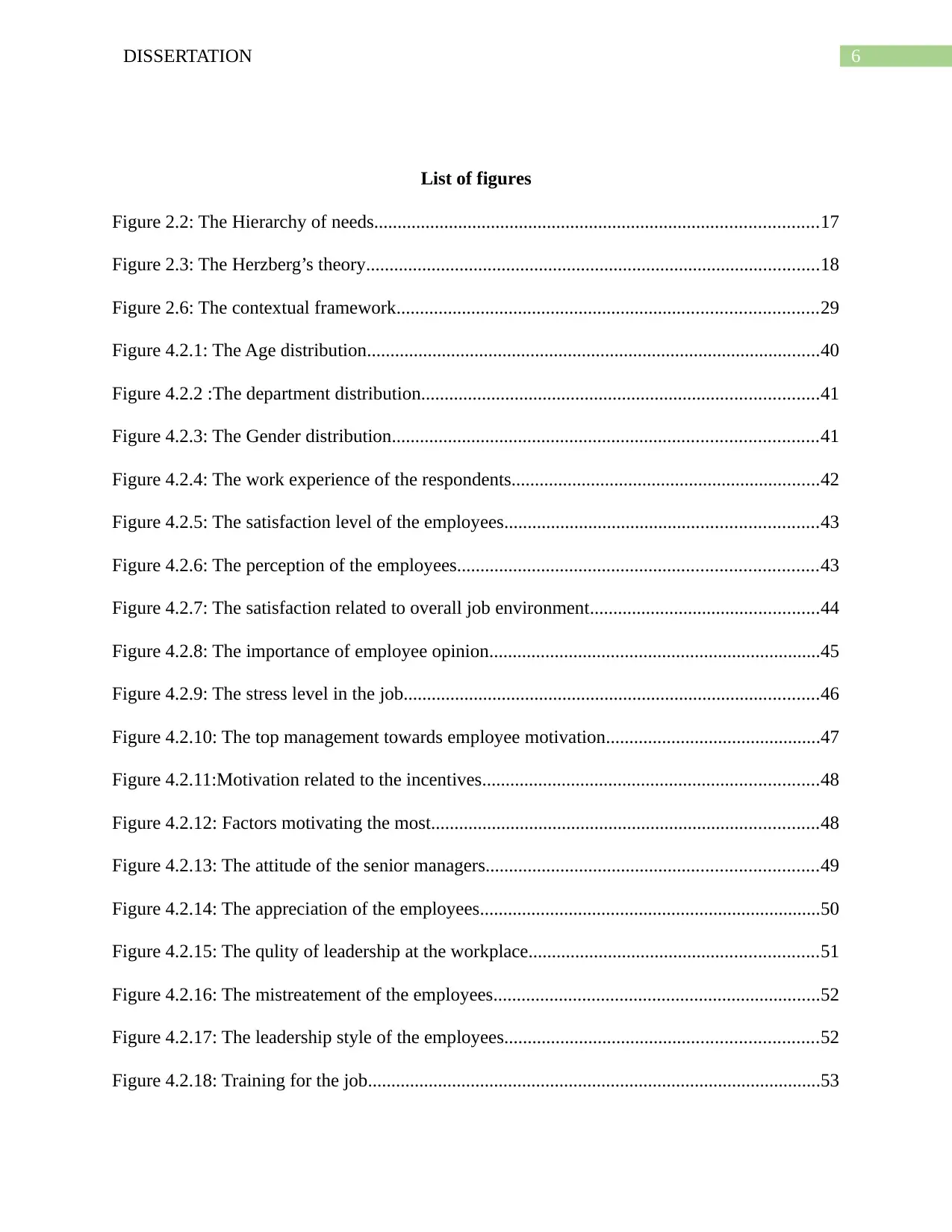
6DISSERTATION
List of figures
Figure 2.2: The Hierarchy of needs...............................................................................................17
Figure 2.3: The Herzberg’s theory.................................................................................................18
Figure 2.6: The contextual framework..........................................................................................29
Figure 4.2.1: The Age distribution.................................................................................................40
Figure 4.2.2 :The department distribution.....................................................................................41
Figure 4.2.3: The Gender distribution...........................................................................................41
Figure 4.2.4: The work experience of the respondents..................................................................42
Figure 4.2.5: The satisfaction level of the employees...................................................................43
Figure 4.2.6: The perception of the employees.............................................................................43
Figure 4.2.7: The satisfaction related to overall job environment.................................................44
Figure 4.2.8: The importance of employee opinion.......................................................................45
Figure 4.2.9: The stress level in the job.........................................................................................46
Figure 4.2.10: The top management towards employee motivation..............................................47
Figure 4.2.11:Motivation related to the incentives........................................................................48
Figure 4.2.12: Factors motivating the most...................................................................................48
Figure 4.2.13: The attitude of the senior managers.......................................................................49
Figure 4.2.14: The appreciation of the employees.........................................................................50
Figure 4.2.15: The qulity of leadership at the workplace..............................................................51
Figure 4.2.16: The mistreatement of the employees......................................................................52
Figure 4.2.17: The leadership style of the employees...................................................................52
Figure 4.2.18: Training for the job.................................................................................................53
List of figures
Figure 2.2: The Hierarchy of needs...............................................................................................17
Figure 2.3: The Herzberg’s theory.................................................................................................18
Figure 2.6: The contextual framework..........................................................................................29
Figure 4.2.1: The Age distribution.................................................................................................40
Figure 4.2.2 :The department distribution.....................................................................................41
Figure 4.2.3: The Gender distribution...........................................................................................41
Figure 4.2.4: The work experience of the respondents..................................................................42
Figure 4.2.5: The satisfaction level of the employees...................................................................43
Figure 4.2.6: The perception of the employees.............................................................................43
Figure 4.2.7: The satisfaction related to overall job environment.................................................44
Figure 4.2.8: The importance of employee opinion.......................................................................45
Figure 4.2.9: The stress level in the job.........................................................................................46
Figure 4.2.10: The top management towards employee motivation..............................................47
Figure 4.2.11:Motivation related to the incentives........................................................................48
Figure 4.2.12: Factors motivating the most...................................................................................48
Figure 4.2.13: The attitude of the senior managers.......................................................................49
Figure 4.2.14: The appreciation of the employees.........................................................................50
Figure 4.2.15: The qulity of leadership at the workplace..............................................................51
Figure 4.2.16: The mistreatement of the employees......................................................................52
Figure 4.2.17: The leadership style of the employees...................................................................52
Figure 4.2.18: Training for the job.................................................................................................53
Paraphrase This Document
Need a fresh take? Get an instant paraphrase of this document with our AI Paraphraser
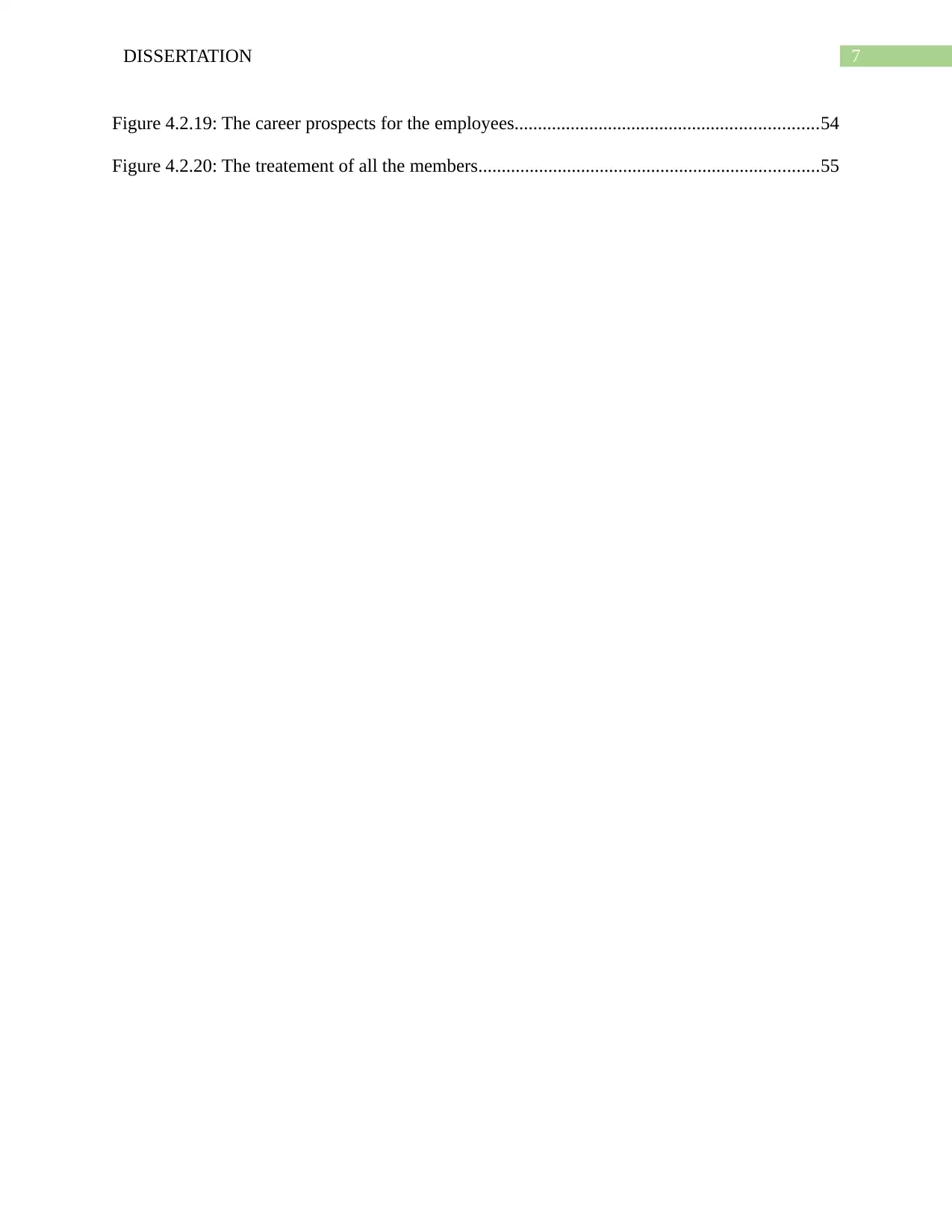
7DISSERTATION
Figure 4.2.19: The career prospects for the employees.................................................................54
Figure 4.2.20: The treatement of all the members.........................................................................55
Figure 4.2.19: The career prospects for the employees.................................................................54
Figure 4.2.20: The treatement of all the members.........................................................................55
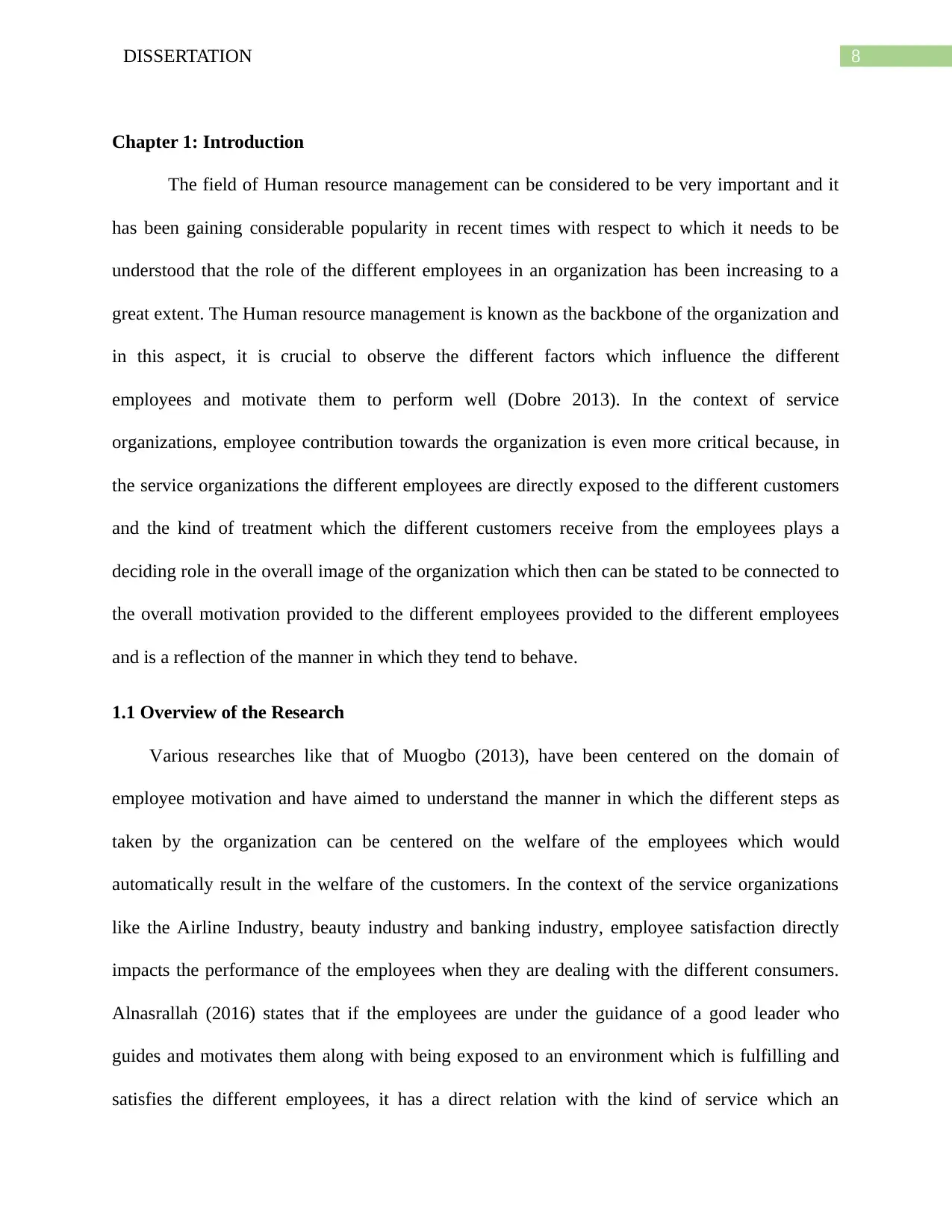
8DISSERTATION
Chapter 1: Introduction
The field of Human resource management can be considered to be very important and it
has been gaining considerable popularity in recent times with respect to which it needs to be
understood that the role of the different employees in an organization has been increasing to a
great extent. The Human resource management is known as the backbone of the organization and
in this aspect, it is crucial to observe the different factors which influence the different
employees and motivate them to perform well (Dobre 2013). In the context of service
organizations, employee contribution towards the organization is even more critical because, in
the service organizations the different employees are directly exposed to the different customers
and the kind of treatment which the different customers receive from the employees plays a
deciding role in the overall image of the organization which then can be stated to be connected to
the overall motivation provided to the different employees provided to the different employees
and is a reflection of the manner in which they tend to behave.
1.1 Overview of the Research
Various researches like that of Muogbo (2013), have been centered on the domain of
employee motivation and have aimed to understand the manner in which the different steps as
taken by the organization can be centered on the welfare of the employees which would
automatically result in the welfare of the customers. In the context of the service organizations
like the Airline Industry, beauty industry and banking industry, employee satisfaction directly
impacts the performance of the employees when they are dealing with the different consumers.
Alnasrallah (2016) states that if the employees are under the guidance of a good leader who
guides and motivates them along with being exposed to an environment which is fulfilling and
satisfies the different employees, it has a direct relation with the kind of service which an
Chapter 1: Introduction
The field of Human resource management can be considered to be very important and it
has been gaining considerable popularity in recent times with respect to which it needs to be
understood that the role of the different employees in an organization has been increasing to a
great extent. The Human resource management is known as the backbone of the organization and
in this aspect, it is crucial to observe the different factors which influence the different
employees and motivate them to perform well (Dobre 2013). In the context of service
organizations, employee contribution towards the organization is even more critical because, in
the service organizations the different employees are directly exposed to the different customers
and the kind of treatment which the different customers receive from the employees plays a
deciding role in the overall image of the organization which then can be stated to be connected to
the overall motivation provided to the different employees provided to the different employees
and is a reflection of the manner in which they tend to behave.
1.1 Overview of the Research
Various researches like that of Muogbo (2013), have been centered on the domain of
employee motivation and have aimed to understand the manner in which the different steps as
taken by the organization can be centered on the welfare of the employees which would
automatically result in the welfare of the customers. In the context of the service organizations
like the Airline Industry, beauty industry and banking industry, employee satisfaction directly
impacts the performance of the employees when they are dealing with the different consumers.
Alnasrallah (2016) states that if the employees are under the guidance of a good leader who
guides and motivates them along with being exposed to an environment which is fulfilling and
satisfies the different employees, it has a direct relation with the kind of service which an
⊘ This is a preview!⊘
Do you want full access?
Subscribe today to unlock all pages.

Trusted by 1+ million students worldwide
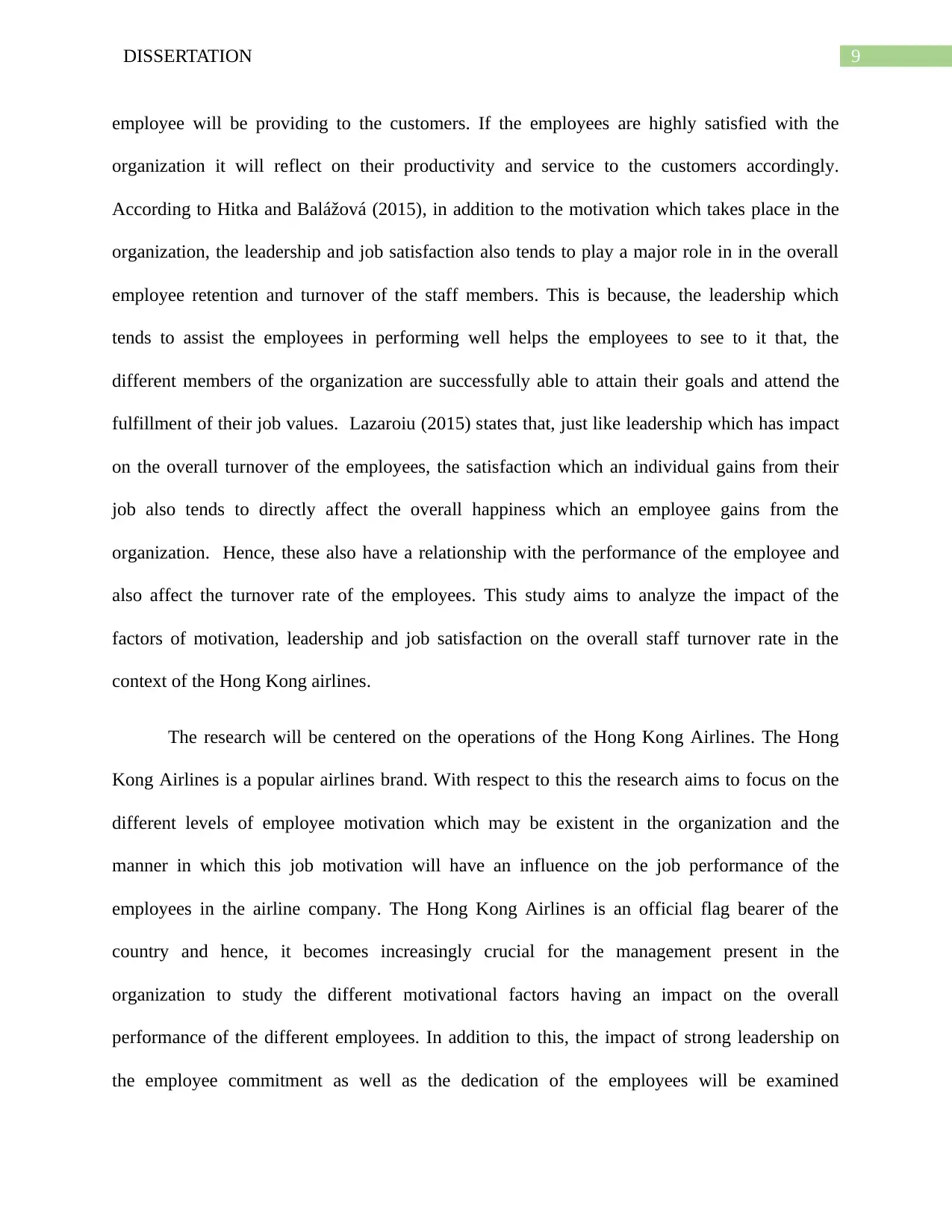
9DISSERTATION
employee will be providing to the customers. If the employees are highly satisfied with the
organization it will reflect on their productivity and service to the customers accordingly.
According to Hitka and Balážová (2015), in addition to the motivation which takes place in the
organization, the leadership and job satisfaction also tends to play a major role in in the overall
employee retention and turnover of the staff members. This is because, the leadership which
tends to assist the employees in performing well helps the employees to see to it that, the
different members of the organization are successfully able to attain their goals and attend the
fulfillment of their job values. Lazaroiu (2015) states that, just like leadership which has impact
on the overall turnover of the employees, the satisfaction which an individual gains from their
job also tends to directly affect the overall happiness which an employee gains from the
organization. Hence, these also have a relationship with the performance of the employee and
also affect the turnover rate of the employees. This study aims to analyze the impact of the
factors of motivation, leadership and job satisfaction on the overall staff turnover rate in the
context of the Hong Kong airlines.
The research will be centered on the operations of the Hong Kong Airlines. The Hong
Kong Airlines is a popular airlines brand. With respect to this the research aims to focus on the
different levels of employee motivation which may be existent in the organization and the
manner in which this job motivation will have an influence on the job performance of the
employees in the airline company. The Hong Kong Airlines is an official flag bearer of the
country and hence, it becomes increasingly crucial for the management present in the
organization to study the different motivational factors having an impact on the overall
performance of the different employees. In addition to this, the impact of strong leadership on
the employee commitment as well as the dedication of the employees will be examined
employee will be providing to the customers. If the employees are highly satisfied with the
organization it will reflect on their productivity and service to the customers accordingly.
According to Hitka and Balážová (2015), in addition to the motivation which takes place in the
organization, the leadership and job satisfaction also tends to play a major role in in the overall
employee retention and turnover of the staff members. This is because, the leadership which
tends to assist the employees in performing well helps the employees to see to it that, the
different members of the organization are successfully able to attain their goals and attend the
fulfillment of their job values. Lazaroiu (2015) states that, just like leadership which has impact
on the overall turnover of the employees, the satisfaction which an individual gains from their
job also tends to directly affect the overall happiness which an employee gains from the
organization. Hence, these also have a relationship with the performance of the employee and
also affect the turnover rate of the employees. This study aims to analyze the impact of the
factors of motivation, leadership and job satisfaction on the overall staff turnover rate in the
context of the Hong Kong airlines.
The research will be centered on the operations of the Hong Kong Airlines. The Hong
Kong Airlines is a popular airlines brand. With respect to this the research aims to focus on the
different levels of employee motivation which may be existent in the organization and the
manner in which this job motivation will have an influence on the job performance of the
employees in the airline company. The Hong Kong Airlines is an official flag bearer of the
country and hence, it becomes increasingly crucial for the management present in the
organization to study the different motivational factors having an impact on the overall
performance of the different employees. In addition to this, the impact of strong leadership on
the employee commitment as well as the dedication of the employees will be examined
Paraphrase This Document
Need a fresh take? Get an instant paraphrase of this document with our AI Paraphraser
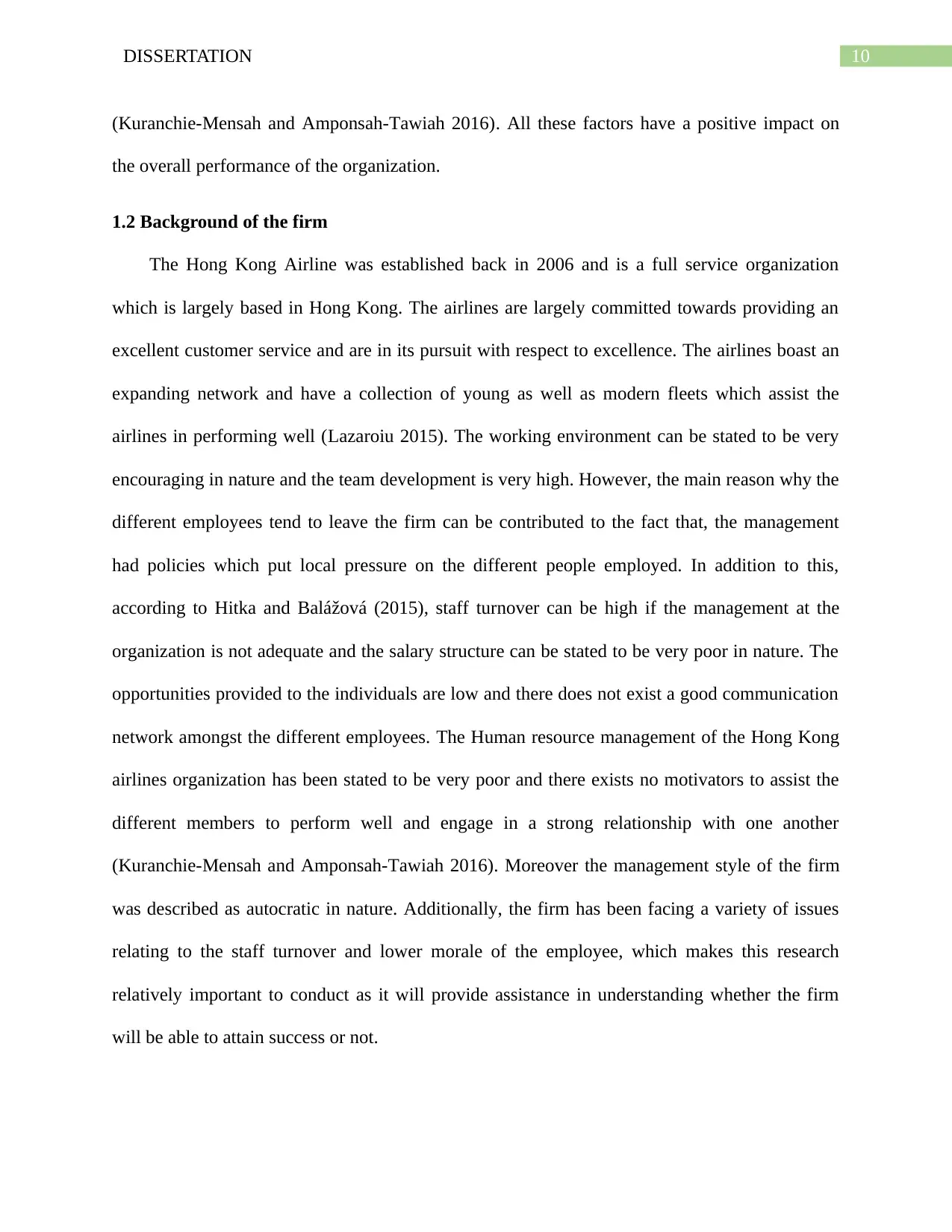
10DISSERTATION
(Kuranchie-Mensah and Amponsah-Tawiah 2016). All these factors have a positive impact on
the overall performance of the organization.
1.2 Background of the firm
The Hong Kong Airline was established back in 2006 and is a full service organization
which is largely based in Hong Kong. The airlines are largely committed towards providing an
excellent customer service and are in its pursuit with respect to excellence. The airlines boast an
expanding network and have a collection of young as well as modern fleets which assist the
airlines in performing well (Lazaroiu 2015). The working environment can be stated to be very
encouraging in nature and the team development is very high. However, the main reason why the
different employees tend to leave the firm can be contributed to the fact that, the management
had policies which put local pressure on the different people employed. In addition to this,
according to Hitka and Balážová (2015), staff turnover can be high if the management at the
organization is not adequate and the salary structure can be stated to be very poor in nature. The
opportunities provided to the individuals are low and there does not exist a good communication
network amongst the different employees. The Human resource management of the Hong Kong
airlines organization has been stated to be very poor and there exists no motivators to assist the
different members to perform well and engage in a strong relationship with one another
(Kuranchie-Mensah and Amponsah-Tawiah 2016). Moreover the management style of the firm
was described as autocratic in nature. Additionally, the firm has been facing a variety of issues
relating to the staff turnover and lower morale of the employee, which makes this research
relatively important to conduct as it will provide assistance in understanding whether the firm
will be able to attain success or not.
(Kuranchie-Mensah and Amponsah-Tawiah 2016). All these factors have a positive impact on
the overall performance of the organization.
1.2 Background of the firm
The Hong Kong Airline was established back in 2006 and is a full service organization
which is largely based in Hong Kong. The airlines are largely committed towards providing an
excellent customer service and are in its pursuit with respect to excellence. The airlines boast an
expanding network and have a collection of young as well as modern fleets which assist the
airlines in performing well (Lazaroiu 2015). The working environment can be stated to be very
encouraging in nature and the team development is very high. However, the main reason why the
different employees tend to leave the firm can be contributed to the fact that, the management
had policies which put local pressure on the different people employed. In addition to this,
according to Hitka and Balážová (2015), staff turnover can be high if the management at the
organization is not adequate and the salary structure can be stated to be very poor in nature. The
opportunities provided to the individuals are low and there does not exist a good communication
network amongst the different employees. The Human resource management of the Hong Kong
airlines organization has been stated to be very poor and there exists no motivators to assist the
different members to perform well and engage in a strong relationship with one another
(Kuranchie-Mensah and Amponsah-Tawiah 2016). Moreover the management style of the firm
was described as autocratic in nature. Additionally, the firm has been facing a variety of issues
relating to the staff turnover and lower morale of the employee, which makes this research
relatively important to conduct as it will provide assistance in understanding whether the firm
will be able to attain success or not.
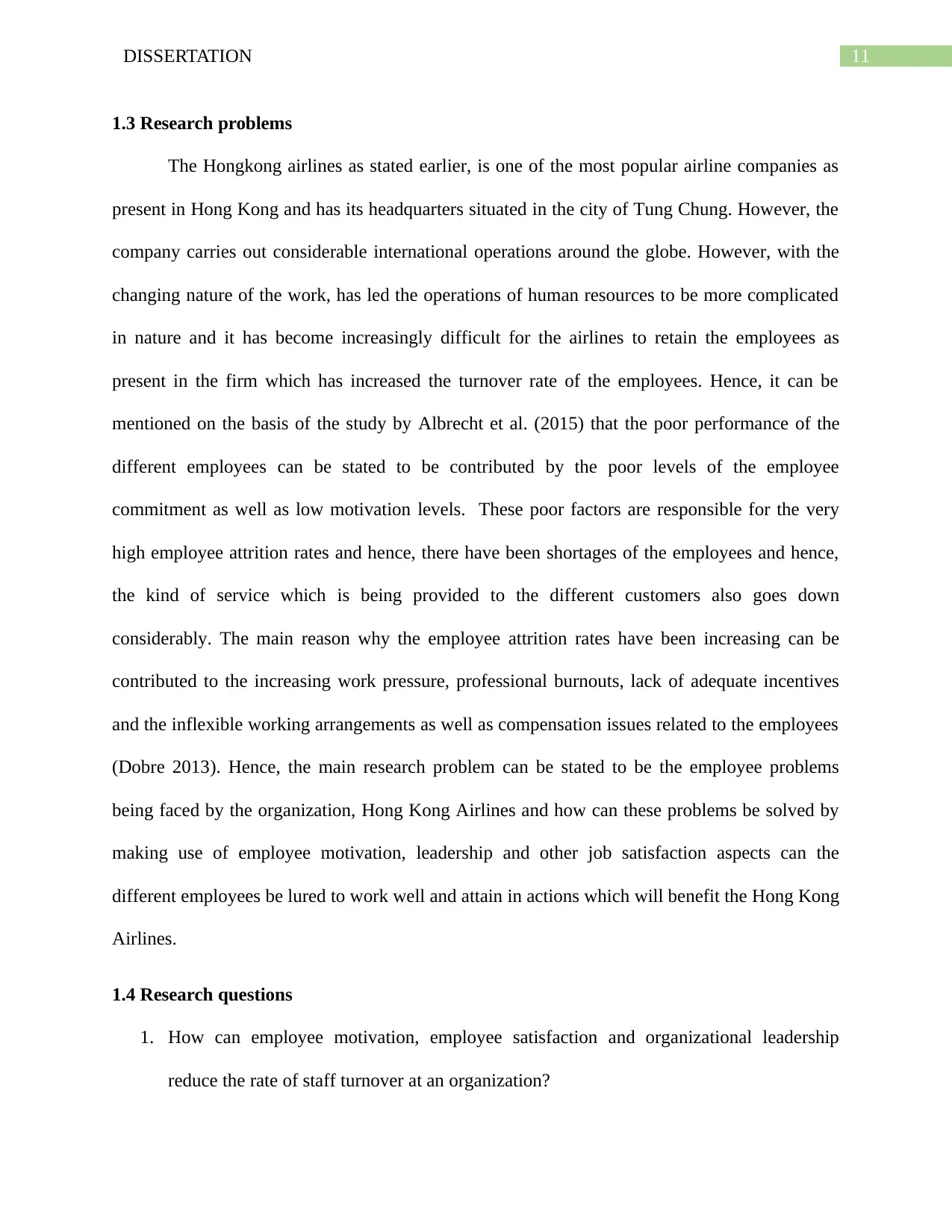
11DISSERTATION
1.3 Research problems
The Hongkong airlines as stated earlier, is one of the most popular airline companies as
present in Hong Kong and has its headquarters situated in the city of Tung Chung. However, the
company carries out considerable international operations around the globe. However, with the
changing nature of the work, has led the operations of human resources to be more complicated
in nature and it has become increasingly difficult for the airlines to retain the employees as
present in the firm which has increased the turnover rate of the employees. Hence, it can be
mentioned on the basis of the study by Albrecht et al. (2015) that the poor performance of the
different employees can be stated to be contributed by the poor levels of the employee
commitment as well as low motivation levels. These poor factors are responsible for the very
high employee attrition rates and hence, there have been shortages of the employees and hence,
the kind of service which is being provided to the different customers also goes down
considerably. The main reason why the employee attrition rates have been increasing can be
contributed to the increasing work pressure, professional burnouts, lack of adequate incentives
and the inflexible working arrangements as well as compensation issues related to the employees
(Dobre 2013). Hence, the main research problem can be stated to be the employee problems
being faced by the organization, Hong Kong Airlines and how can these problems be solved by
making use of employee motivation, leadership and other job satisfaction aspects can the
different employees be lured to work well and attain in actions which will benefit the Hong Kong
Airlines.
1.4 Research questions
1. How can employee motivation, employee satisfaction and organizational leadership
reduce the rate of staff turnover at an organization?
1.3 Research problems
The Hongkong airlines as stated earlier, is one of the most popular airline companies as
present in Hong Kong and has its headquarters situated in the city of Tung Chung. However, the
company carries out considerable international operations around the globe. However, with the
changing nature of the work, has led the operations of human resources to be more complicated
in nature and it has become increasingly difficult for the airlines to retain the employees as
present in the firm which has increased the turnover rate of the employees. Hence, it can be
mentioned on the basis of the study by Albrecht et al. (2015) that the poor performance of the
different employees can be stated to be contributed by the poor levels of the employee
commitment as well as low motivation levels. These poor factors are responsible for the very
high employee attrition rates and hence, there have been shortages of the employees and hence,
the kind of service which is being provided to the different customers also goes down
considerably. The main reason why the employee attrition rates have been increasing can be
contributed to the increasing work pressure, professional burnouts, lack of adequate incentives
and the inflexible working arrangements as well as compensation issues related to the employees
(Dobre 2013). Hence, the main research problem can be stated to be the employee problems
being faced by the organization, Hong Kong Airlines and how can these problems be solved by
making use of employee motivation, leadership and other job satisfaction aspects can the
different employees be lured to work well and attain in actions which will benefit the Hong Kong
Airlines.
1.4 Research questions
1. How can employee motivation, employee satisfaction and organizational leadership
reduce the rate of staff turnover at an organization?
⊘ This is a preview!⊘
Do you want full access?
Subscribe today to unlock all pages.

Trusted by 1+ million students worldwide
1 out of 79
Related Documents
Your All-in-One AI-Powered Toolkit for Academic Success.
+13062052269
info@desklib.com
Available 24*7 on WhatsApp / Email
![[object Object]](/_next/static/media/star-bottom.7253800d.svg)
Unlock your academic potential
Copyright © 2020–2025 A2Z Services. All Rights Reserved. Developed and managed by ZUCOL.





